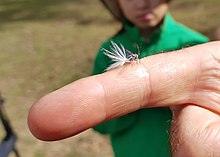Callipappus australis, commonly known as the bird of paradise fly,[1] is a species of scale insect in the family Callipappidae. It is native to Australia where it occurs in Queensland and New South Wales.[2]
| Bird of paradise fly | |
|---|---|
| Scientific classification | |
| Domain: | Eukaryota |
| Kingdom: | Animalia |
| Phylum: | Arthropoda |
| Class: | Insecta |
| Order: | Hemiptera |
| Suborder: | Sternorrhyncha |
| Family: | Callipappidae |
| Genus: | Callipappus |
| Species: | C. australis
|
| Binomial name | |
| Callipappus australis (Maskell, 1890)
| |

Description
editThe bird of paradise fly exhibits sexual dimorphism. The adult female is up to about 2 cm (0.8 in) in length and a dark bluish-black or purplish colour. It is an elongated oval in shape with a plump, domed appearance. It has three pairs of legs, but no wings. The adult male in contrast is much smaller and resembles a fly. It has a slender, violet-coloured body, three pairs of legs, a pair of translucent wings and a tuft of long glassy white waxen filaments protruding from the tip of the abdomen.[2]
Distribution
editThis species of scale insect is native to Australia where it occurs in Queensland and New South Wales.[2]
Biology
editAdult males and females emerge from the ground in the autumn. The female climbs up a tree, post or any other vertical surface and this is where mating takes place. After mating, the female attaches herself to a surface and invaginates her abdomen, creating a "marsupium" in which she lays a batch of eggs. She dies soon thereafter, her cuticle making a leathery protective casing for the eggs. The first instar nymphs, known as crawlers, descend to the ground and attach themselves to the roots of plants by inserting their piercing mouthparts. A waxen cyst forms around them. Their plant hosts include Banksia and probably Xanthorrhoea and other mallee, woodland and heathland plants.[1] The feeding stages live entirely underground, sucking sap from roots, but their range of host plants has not been fully elucidated;[3] the type specimens were found on the trunk of Angophora, but it is quite likely that this is not a host plant, and merely provides an elevated position for breeding activities.[2]
References
edit- ^ a b Gullian, P.J. & Brookes, H.M. (1998). "Giant females and bird-of-paradise flies: Notes on the biology of Callipappus Guérin-Méneville (Hemiptera: Margarodidae)". Austral Entomology. 37 (1): 2–7. doi:10.1111/j.1440-6055.1998.tb01534.x.
- ^ a b c d "Callipappus australis". ScaleNet. Retrieved 19 January 2020.
- ^ Miller, D.; Rung, A.; Parikh, G.; Venable, G.; Redford, A.J.; Evans, G.A. & Gill, R.J. (1 April 2014). "Callipappidae". Scale Insects. Archived from the original on 9 February 2020. Retrieved 19 January 2020.